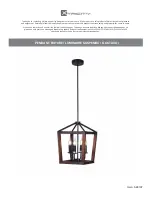
Salt Bath 709 / 718 / 818
Installation and Operating Manual
North American Model
June 2019
Page
27
of
36
Salt Bath Maintenance
Thermocouples
Evenheat Salt Bath models contain 3 thermocouples: Immersion, Chamber and Over-Temp. If any of these thermocouples fail operation of the salt bath unit is
impossible.
The Immersion thermocouple, by the nature of its use, is expected to fail before the chamber or over-temp thermocouples. We suggest having a spare at-the-ready.
The immersion thermocouple is held in place with the Immersion Thermocouple Mount. This mount is reusable, for the most part, but may need replacing at some
point.
Technically, the Immersion thermocouple is a Type K, 3/16" Inconel sheath, 18" long, bent at 90° with standard size male quick connect, Evenheat part
#11647.310. It is supplied with a grounding-wire lug. It is not supplied with the lead or ground wire running back to the control panel.
Immersion Thermocouple Mount part #11647.320.
Chamber and Over-Temp thermocouples are capable of failing as well although given their use within the firing chamber we don’t expect it to be soon or often.
Technically, the Chamber thermocouple is a Type K Thermocouple, 1/8" Inconel sheath, 8" long, straight with standard size male quick connect, Evenheat
part #11647.305. It is supplied with a grounding-wire lug. It is not supplied with the lead or ground wire running back to the control panel.
Technically, the Over-Temp thermocouple is a Type K Thermocouple, 1/8" Inconel sheath, 6" long, bent at 90° with standard size male quick connect,
Evenheat #11647.315. It is supplied with the ground wire, grounding lug hardware, and lead which connects to the back of the control panel.
Grounding Circuit
Salt Bath models are designed with dedicated grounding paths for electrical safety. These dedicated ground paths include the ground strap on the salt pot itself and
the ground wires fitted to each thermocouple. These grounds shall be inspected periodically for proper placement and circuit integrity.
The salt pot ground consists of a braided ground strap that is attached at both the salt pot and control panel. Keep a close eye on the end that is connected to the salt
pot. Look for any loose connections, tighten if necessary. Also look for corrosion at this connection as it will corrode with use. Replace damaged ground strap and
hardware.
We use plated, braided, 18” (eye-to-eye) x ½” ground strap, Evenheat part #08298.235.
We have mentioned this at various points in this manual but it bears repeating: Molten salt is electrically conductive (as in it will carry electricity). Because of this it is
vitally important that the salt pot and thermocouples be connected to the ground circuit of the salt bath model. If an electrical fault occurs, such as a heating element
coming into contact with the salt pot, the ground connection safely shorts out the circuit and causes protective breakers or fuses to open (which is what we want).
Vacuuming Salt Pot Scale
Evenheat supplies salt pots fabricated from 316 Stainless. Salt pots can be made from a variety of other metals as well. During use the salt pot with oxidize and
produce scale. This scale will fall away from the pot and find its way to the floor and interior walls of the chamber. Evenheat recommends that you vacuum away this
scale on a periodic basis, perhaps every 15 to 20 times of use (depending upon pot material).
Fiber Gasketing at Pot Rim
Our salt bath lids are designed with a groove that allows the user to insert a section of fiber between the pot and lid itself. This gasket is intended to act as a thermal
barrier or seal. Typically this fiber can be used repeatedly. At some point you will need to replace it. This fiber is a useful and needed aspect of the salt bath design
and we highly recommend that you use it and continue to keep it in good condition.
Replacement fiber gasketing material is Evenheat part #06423.305
Drip Shields
Evenheat salt bath models include “drip shields” that help protect the firebrick from salt drag-out during use. These drip shields are stainless and we expect them to
last quite some time. However, if they do begin to fail and allow molten salt to reach the firebrick lid they should be replaced.










































